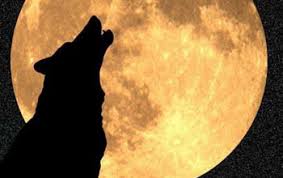 |
| Wolf Moon (Photo: Courtesy NSF) |
Full Moons have been given different names by Native Americans to help track the seasons of the year. There seem to be correlations between the names and what is occurring in nature at that time. According to the Northwest Trek Wildlife Park in Eatonville, WA, wolves “tend to howl more often in the winter months. It was thought the wolves howled due to their hunger; however, there’s no evidence for this.”
 |
| Lakota Wolf (Kagan) |
Wolves are night hunters, and they most often
call to mark territory, locate members
of their pack, organize hunting and reinforce social bonds. The idea that they howl at the moon is most likely
because they tilt their head back as they vocalize.
The Old Farmer's Almanac notes other
interesting names assigned to the January full moon that also relate to cultural
or natural events. Some names relate to weather such as “the harsh coldness of
the season.” Cold Moon or Frost Exploding Moon from the Cree, and Severe Moon
or Hard Moon, referring to the hard crust atop fallen snow, from the Dakota.
There is the Canada Goose Moon of the Tlingit;
no doubt associated with the geese in their area. And, in approximately the
middle of the winter season, the
Assiniboine people refer to it as the Center Moon.
Not just a North American custom, around the
world full moons figure in cultural events. The Weather Channel shares that “Celebrated
as the Moon after Yule, pre-Christian Europeans enjoyed a three-day winter
solstice feast upon the arrival of this first Full Moon.” Also noted “… in
India, [it] signifies the last day of the Hindu calendar celebration Shakambari
Navratri festival honoring the goddess Shakambhari.”
We visited both Wolf Preserve of PA, in Littiz, PA, and the Lakota Wolf Preserve in Columbia, NJ. During our March visit to Lakota we heard quite a bit of howling during the day.
# # #
SPECIAL Price reduction.





No comments:
Post a Comment